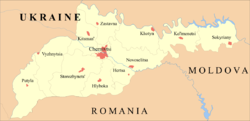
Back تشيرنوفتسي Arabic Chernivtsi AST Tcernivtsi AVK Çernovtsı AZ Черновцы BA Чарнаўцы BE Чарнаўцы BE-X-OLD Чернивци Bulgarian Tchernivtsi BR Černivci BS
Chernivtsi
Чернівці Cernăuți | |
|---|---|
From top, left to right:
| |
| Nickname: | |
 The Chernivtsi City Municipality (center) on the map of Chernivtsi Oblast. | |
| Coordinates: 48°18′0″N 25°56′0″E / 48.30000°N 25.93333°E | |
| Country | |
| Oblast | |
| Raion | Chernivtsi |
| Hromada | Chernivtsi urban |
| First mentioned | 1408 |
| City rights | 14th century |
| Government | |
| • Mayor | Roman Klichuk[3] (United Alternative[4]) |
| Area | |
• Total | 153 km2 (59 sq mi) |
| Elevation | 248 m (814 ft) |
| Population (2022) | |
• Total | 264,298 |
| • Density | 1,700/km2 (4,500/sq mi) |
| Time zone | UTC+2 (EET) |
| • Summer (DST) | UTC+3 (EEST) |
| Postal code | 58000 |
| Area code | +380 372 |
| Vehicle registration | CE/26 |
| Sister cities | Salt Lake City, Konin, Suceava, Nazareth Illit, Saskatoon, Klagenfurt |
| Website | city chernivtsy |

Chernivtsi (Ukrainian: Чернівці, pronounced [tʃerniu̯ˈtsi] ; Romanian: Cernăuți, pronounced [tʃernəˈutsʲ] ; see also other names) is a city in southwestern Ukraine on the upper course of the Prut River. Formerly the capital of the historic region of Bukovina, which is now divided between Romania and Ukraine, Chernivtsi serves as the administrative center for the Chernivtsi urban hromada,[5] the Chernivtsi Raion, and the oblast itself. In 2022, the Chernivtsi population, by estimate, is 264,298 (2022 estimate),[6] and the latest census in 2001 was 240,600.[7]
The first document that refers to this city dates back to 1408,[8] when Chernivtsi was a town in the region of Moldavia, formerly as a defensive fortification, and became the center of Bukovina in 1488. In 1538, Chernivtsi was under the control of the Principality of Moldavia under Polish suzerainty, later under Ottoman Empire suzerainty, and the Moldavian control lasted for two centuries until 1774, when Austria took control of Bukovina in the aftermath of the Russo-Turkish War.[9] Chernivtsi (known at that time as Czernowitz) became the center of the Galicia's Bukovina District until 1848, later becoming the Duchy of Bukovina until 1918. In the aftermath of World War I, Romania united with Bukovina in 1918, which led to the city regaining its Romanian name of Cernăuți; this lasted until the Soviets occupied Bessarabia and Northern Bukovina. Chernivtsi was under the control of the Soviet Union from 1940 to 1941, after which Romania recovered the city, and then again from 1944 until the dissolution of the Soviet Union, after which it became part of independent Ukraine.
Chernivtsi is viewed as one of Western Ukraine's main cultural centers. The city is also considered one of Ukraine's important educational and architectural sites. Historically a cosmopolitan community, Chernivtsi was once dubbed "Little Vienna"[1][2] and "Jerusalem upon the Prut". The city is a major regional rail and road transportation hub, also housing an international airport.
- ^ a b Zhytariuk, Natalia (2 November 2004). "Bukovyna Week in Austria". Den. Archived from the original on 20 March 2005. Retrieved 26 September 2007.
- ^ a b "Bukovina. The Beech Tree Land". Ukraine Cognita. 23 February 2005. Archived from the original on 28 July 2011. Retrieved 26 September 2007.
- ^ "Roman Klichuk wins Chernivtsi mayoral election". Ukrinform. 30 November 2020.
- ^ В Чернівцях оголосили офіційні результати виборів мера [The official results of the mayoral election have been announced in Chernivtsi]. Ukrainska Pravda (in Ukrainian). 30 November 2020.
- ^ Черновицкая громада (in Russian). Портал об'єднаних громад України.
- ^ Чисельність наявного населення України на 1 січня 2022 [Number of Present Population of Ukraine, as of January 1, 2022] (PDF) (in Ukrainian and English). Kyiv: State Statistics Service of Ukraine. Archived (PDF) from the original on 4 July 2022.
- ^ "About number and composition population of Chernivtsi Region by data All-Ukrainian Population Census '2001". State Statistics Committee of Ukraine. Archived from the original on 26 December 2005. Retrieved 2012-12-05.
- ^ "Chernivtsi". Encyclopædia Britannica Online. Retrieved 18 October 2022.
- ^ Zhukovskyi, Arkadii (2010). "Chernivtsi". Encyclopedia of Ukraine. Retrieved 18 October 2022.









